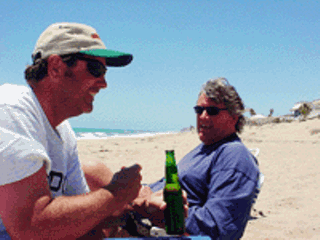But for ecologists studying the gulf, it's a rich ecosystem containing one third of Earth's marine mammal species, several hundred bird species and as many as 800 types of fish. The gulf is also home to dolphins, sharks, rays, seals, sea lions, four different species of whales and five species of sea turtles.
The gulf's ecological diversity is due in part to its unique geography. Located east of the Baja California peninsula and west of mainland Mexico, and flowing into the Pacific Ocean to the south, the Gulf of California features rocky cliffs as well as sandy beaches dotted with cacti.
The Gulf of California also represents an important breeding area for threatened animals, some found nowhere else on earth. Blue whales have been known to calve in the Gulf of California, and the gulf's hundreds of islands provide crucial nesting sites for seabirds. UNESCO's World Heritage nomination evaluation describes the gulf region as a nesting site for more than 90 percent of the worldwide population of Heermann's Gulls and home to the fourth largest population of the blue-footed booby.
Several uncommon plant species are found in the area's lagoons, oases and deserts, including the cardón and saguaro, two of the world's largest species of cacti.
In some ways, the Gulf of California--also known as the Sea of Cortez--is an ecological success story, according to Eric Mellink, a senior scientist with the Centro de Investigación Cientifica y de Educacion Superior, who has dedicated himself to research in the gulf.
Mellink, who spoke to Tucsonans at a luncheon last week, says that many threatened species have bounced back since the Mexican government enacted environmental restrictions in the 1960s.
But the flora and fauna of the gulf are facing a host of threats ranging from the well-known issue of overfishing to the more insidious effects of pesticide use in the region. Overfishing has exhausted the gulf's population of fish and reduces the availability of food for seabirds, as well as marine mammals such as whales and dolphins. Bycatch, the capture of unintended species, occurs frequently with common net fishing and trawling methods.
Even farmed seafood affects the gulf environment. The fertilizers released into the water through shrimp farming decrease water quality and are thought to have harmed the gulf's population of mangrove trees. Pollution from other sources, such as agricultural runoff and drug trafficking, presents a significant problem for terrestrial and aquatic species.
Rampant development in popular vacation spots such as Puerto Peñasco destroys habitat for local plants and animals, increases coastal pollution and is suspected to play a role in toxic algae blooms. Tourism has been a mixed blessing for these areas: the increasingly popular option of "ecotourism," focusing on the area's natural attractions, can increase visitors' awareness of the need for conservation.
The problems, says Mellink, are caused when tourists--and even researchers--visit formerly isolated areas, such as the small islands off the gulf's coast. The disruption can cause breeding problems with shorebirds and introduce potentially harmful alien species, such as rats or invasive grass seeds to the area.
Dozens of alien species have already been introduced to the islands, including goats, cattle, burros, bighorn sheep, cats, dogs, jackrabbits, rodents, geckos and house sparrows. These newcomers upset the natural balance; cats can cause extinction of small animals, goats modify and destroy habitat, and any new animal can pose a disease risk to members of the old population.
While the ecological threats are numerous, Mellink holds out hope that conservation efforts can be successful.
"I think we can do it, but we have to work hard on it," Mellink said.
One of the region's most famous--and threatened--residents is the timid harbor porpoise, better known as the vaquita. The world's smallest aquatic mammal, the adult vaquita measures four to five feet long and weighs approximately 120 pounds. Ecologists at Puerto Peñasco's Centro Intercultural de Estudios de Desiertos y Océanos--a bi-national research station better known as CEDO Intercultural--say that gill nets, used to capture everything from shrimp to sharks, are responsible for more than 30 vaquita deaths per year--a high mortality rate for an estimated total population of less than 600, according to a 1997 survey.
Found only in the northern gulf, vaquitas are considered by many researchers to be the world's most endangered marine cetacean. In the early 1990s, negotiations for the North American Free Trade Agreement boosted awareness of the vaquita's plight, and in 1993, the northern Gulf of California was named a Biosphere Reserve to protect the vaquita and other local species.
Without adequate enforcement, though, the vaquita population has declined; it was listed as "Critically Endangered" by the World Conservation Union (known as IUCN) in 1996 and by the Convention on International Trade in Endangered Species in 1997.
Mellink's talk was the first of two sponsored in part by the Arizona-Sonora Desert Museum's Center for Sonoran Desert Studies.
Jeffrey Seminoff of the U.S. National Marine Fisheries Service and Hoyt Peckham of the University of California, Santa Cruz, discuss threats to sea turtles in the gulf and along the Baja California peninsula's Pacific coast at noon on Tuesday, March 14, at the Doubletree Hotel, 445 S. Alvernon Way. The talk will also focus on conservation activities in the gulf region.
Cost is $25 or $22.50 for Desert Museum members, which includes lunch. Call 883-3086 or visit the Desert Museum's Web site for more information.


















